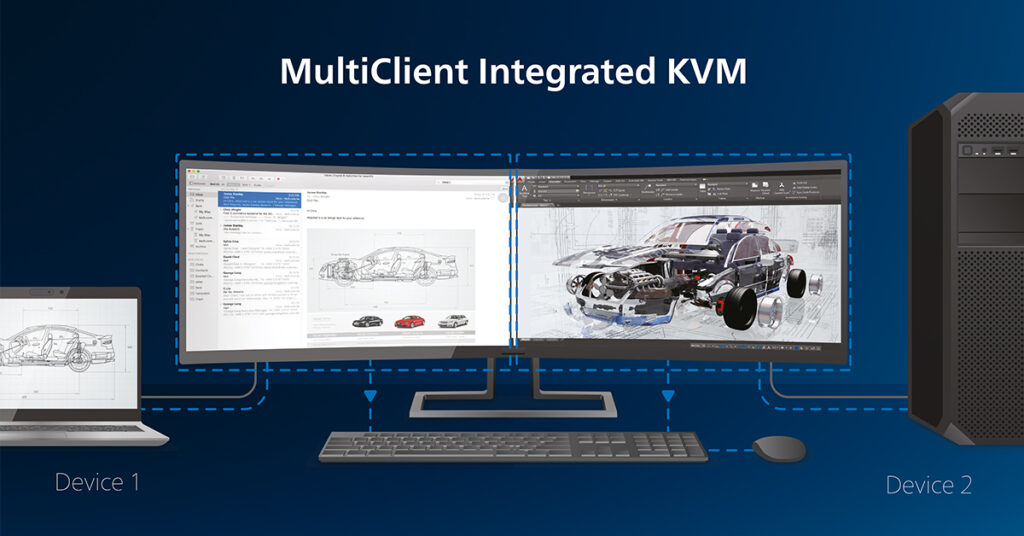What is a KVM Switch?

A KVM switch, short for Keyboard, Video, and Mouse switch, is traditionally a hardware device that allows users to control multiple computers using a single set of peripherals.
Let’s dive into what KVM is, what it means for your workspace, and how it has developed into a built-in function.
What is a KVM switch used for?
Traditionally, KVM switches were an external mechanism that was used to switch between different PCs without having to swap out cables or use multiple sets of peripherals constantly. This saved time, increased productivity, and streamlined workflow; making it an essential tool for professionals.
Nowadays, the modern KVM switch is used for the same purpose, but it is built-in into the monitor.
How does a KVM switch work on a monitor?
When it comes to using a KVM switch on a monitor, the device functions by allowing users to switch between different computers by simply pressing a button or using a hotkey combination on their keyboard. The KVM switch then connects to the monitor through a video cable, thereby enabling the monitor to display the output from the selected computer.
Some KVM switches can support multiple monitors, allowing users to connect multiple displays and switch between computers on different screens.
Which monitors have a built-in KVM switch?
In our Philips professional monitor line, we offer monitors with built-in KVM switches, making it even easier to switch between sources. The feature on these monitors, named MultiClient Integrated KVM, works with two different PCs and can be controlled with a simple, convenient button.
Check out our latest model with MultiClient Integrated KVM, the Philips 45B1U6900CH, here.
What to look for when buying a KVM switch?
When it comes to buying a KVM switch (built-in or not), there are several factors to consider to ensure that you get the right device for your needs. Below you will find these factors listed:
- Determine the number of computers you need to control and ensure that the KVM switch you choose supports the required number of ports/PCs.
- Consider the ports you need, such as USB, HDMI, DVI, and VGA, and ensure that the KVM switch supports those inputs and outputs.
- Check the maximum resolution that the KVM switch supports to ensure that it can handle the display requirements of your computer(s).
- Consider the switch’s compatibility with different operating systems, the ease of installation and setup, and any additional features such as audio support or remote control.
However, it’s also important to note, as mentioned above with the Philips 45B1U6900CH monitor, virtual KVM is becoming more and more popular and the physical KVM switches are slowly fading out. So, it is best to look for a monitor with built-in KVM. If you would like more information on the Philips 45B1U6900CH monitor, please click here.
Can I use a KVM switch with dual monitors?
Yes, it is possible to use a KVM switch with dual monitors, but it depends on the specific model of the switch and the type of monitor you are using. Most mainstream KVM switches support between one and three monitors.
The Philips 45B1U6900CH is designed to replace a two-monitor setup, however, and has a SuperWide screen measuring at 44.5 inches and 113cm. Diag. So, although a KVM switch can work with almost any setup, one screen can make your workflow a lot more fluid. If you would like more information on the Philips 45B1U6900CH monitor, please click here.
Can a KVM switch work with a laptop?
Yes, a KVM switch can work with a laptop and most new models are optimized for this.
Overall, using a KVM switch with a laptop can be a convenient and efficient way to manage multiple computers from a single set of peripherals, thereby allowing users to maximize productivity and minimize clutter.
What is the difference between a docking station and a KVM switch?
While docking stations and KVM switches may seem similar in functionality, they serve very different purposes. A docking station is a device that connects a laptop or mobile device to a desktop setup, providing additional ports and functionality, including charging, external displays, and Ethernet connectivity. It transforms a laptop into a desktop computer by providing all the necessary peripherals and connections.
Most Philips business line monitors offer integrated USB-C docking with RJ45 in addition to MultiClient Integrated KVM. The USB-C Docking with RJ45 and replace an old, traditional docking station. With this integrated feature, professionals can charge their laptop(s), transfer data rapidly, and easily connect to the internet via RJ45.
To find out more about the new Philips docking solutions, click here.
How does KVM switch to get power?
Depending on their design and specifications, KVM switches can get power from various sources.
Some KVM switches draw power from the computers they are connected to. To give an example, they can use a USB connection for power and data transfer. In this case, the KVM switch relies on the power output from the connected devices, such as the Philips USB-C docking solution, making it a convenient and straightforward solution.
In conclusion, a KVM switch is a device that allows users to control multiple computers or devices from a single set of peripherals, including a keyboard, video, and mouse, but it has recently developed into a virtual business solution. However, in any case, KVM switches provide a convenient and efficient way to manage multiple computers.
